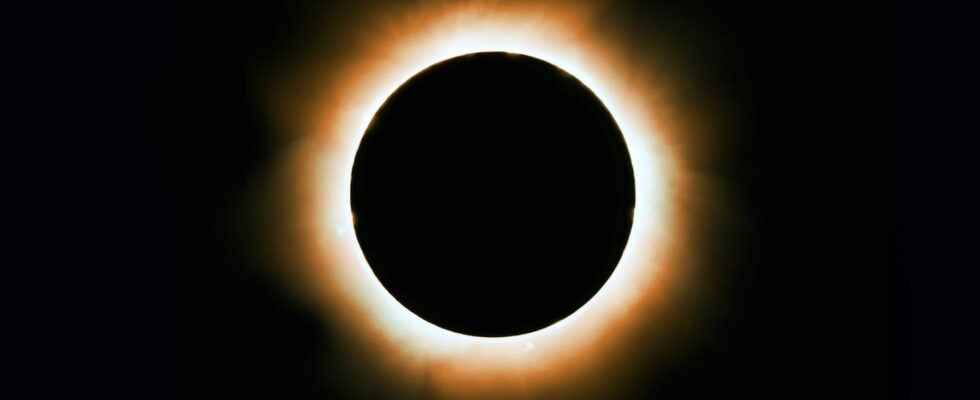A next solar eclipse will take place on Saturday, April 30. We speak of an eclipse when the Moon slips between the Sun and the Earth. Can we see her? If so, at what time? And if so, how to observe it without risk to the eyes?
[Mis à jour le 29 avril 2022 à 16h06] An eclipse is a phenomenon that occurs when the Sun, Moon and Earth are perfectly aligned. The next solar eclipse takes place on Saturday April 30, 2022. It’s about a partial eclipse of the Sun. In general, remember that you should not look directly at the Sun, without special glasses with filter film (to CE standards), a solarscope (screen projection) or with an astronomy instrument. Sunglasses are not enough: risks for the retina (serious retinal damage) are very real, so be careful!
When will the solar eclipse take place on April 30?
L’Institute of Celestial Mechanics and Ephemeris Calculation (IMCCE), the partial eclipse of the Sun will be at its maximum precisely at 10:41 p.m. and 4 seconds. Unfortunately, she will then be invisible in France. Note that April 30 will also mark the arrival of a New Moon.
What are the dates of the next eclipses in France?
An eclipse will occur in April 2022. An eclipse occurs when the Sun, Moon, and Earth are perfectly aligned. Here is the table of the next solar eclipses:
| Solar eclipse date | Hour of maximum visibility (Paris) | Eclipse type |
|---|---|---|
| April 30, 2022 | Non visible | Partial |
| October 25, 2022 | 12:02 | Partial |
| April 20, 2023 | Non visible | Total |
| April 8, 2024 | Non visible | Annular |
| October 2, 2024 | Non visible | Total |
| March 29, 2025 | 12:01 | Annular |
When will the next total eclipse be?
The next total solar eclipse in mainland France will take place on September 3, 2081.
Definition: what is a total, partial, annular eclipse?
A solar eclipse occurs when the Moon comes between the Sun and the Earth. The three stars are therefore perfectly aligned, which leads to the temporary disappearance of the Sun in the shadow of the Moon. There are several types of eclipse:
- The total eclipse: the star disappears completely
- The partial eclipse: the star partially disappears
- The annular eclipse: it is a partial eclipse which reveals a ring of the star (like that of Thursday June 10, 2021)
What are the differences between solar and lunar eclipse?
The solar eclipse differs from the lunar eclipse which occurs when the Earth slips between the Moon and the Sun.
Why watching an eclipse can be dangerous for the eyes?
If looking at the sun in front can be dangerous for the eyes, during a solar eclipse it is even more true because the brightness suddenly changes with the reappearance of the solar disk. “Ultraviolet and infrared rays from the sun can irreversibly burn the retinaassures Dr. Monique Quillard, general practitioner. All you have to do is stare at the sun for a few seconds. The phenomenon is all the more dangerous as it is painless. Victims of this type of burn will only realize it a few hours later, with the onset of violent headaches.. Children must be especially protected. Their eyes are more fragile than those of adults, because the lens allows more rays to pass. People with eye disease must also be very vigilant and protect themselves.
What glasses to wear to watch an eclipse?

From “special eclipse” glasses are sold out a few days before the event. You will find them at the big type brands. Nature&Discovery, Fnac or Decathlon, or from tobacconists and newsagents. They are generally sold between 2 and 3 euros each. Make sure they wear the CE marking (European Community) and a INRS reference number. It is advisable to use only new glasses to avoid any risk of deterioration of the surface after long storage, without special protection, in our homes, advises the Paris Observatory.
► Do not make your own glasses by observing the sun through a CD or an X-ray. Similarly, conventional sunglasses are not sufficient and will not protect your eyes.
To take no risk, the easiest way is to observe the eclipse by projection. “At home, take two sheets of white paper. Make a pinhole in the center of one of the pieces. With your back to the sun, hold the sheet with the pinhole facing you, so that the sun shines through the pinhole and reflects off the other sheet of paper. An image of the eclipse will be projected on the second sheet. The quality of the solar eclipse you can observe with this simple device is truly amazing.“, recommends Dr. Quillard. The “solarscope” is a practical and inexpensive means (device available in specialized shops).
Thanks to Dr Monique Quillard, general practitioner.


